How to Scale Content Creation (Step-By-Step Guide)

Written by Michael Ofei

This post will show you how to scale your content marketing.
(Step-by-step.)
Our team has published and updated over 300 articles in the first half of 2024.
That’s about 50 per month.
Plus: we’ve maintained our content quality while increasing our organic traffic sessions by 30% year-on-year.

And most importantly: This strategy has helped us boost our revenue by 77%.
You’re about to learn precisely how we scaled up.
- Step #1: Break Down Your Writing Process Into TINY Steps
- Step #2: Create an Organized Content Calendar
- Step #3: Plan Out Your Content Schedule for the Next 6-9 Months
- Step #4: Create Detailed Briefs for Each Post
- Step #5: Outline Your Articles
- Step #6: Set Your Team Up for Success With Helpful Resources
- Step #7: Hire Great Editors
- Step #8: Hire Domain Experts or Great Writers and Connect Them with SMEs
- Step #9: Start With a Limited Paid Trial
- Step #10: Repurpose Content into New Formats
- Step #11: Continuously Iterate and Improve
Step #1: Break Down Your Writing Process Into TINY Steps
It’s easy to fall into the trap of thinking of “writing content” as a single step.
Creating content is actually made up of several smaller steps.
If you try to do all of these steps yourself (at a high standard), you won’t be able to achieve the publishing volume needed to scale.
Backlinko’s founder, Brian Dean, started as a solopreneur, writing and publishing articles by himself.
Fortunately, because he focused 100% on quality over quantity, the Backlinko blog grew like crazy. Even though he published an article every four to six weeks.
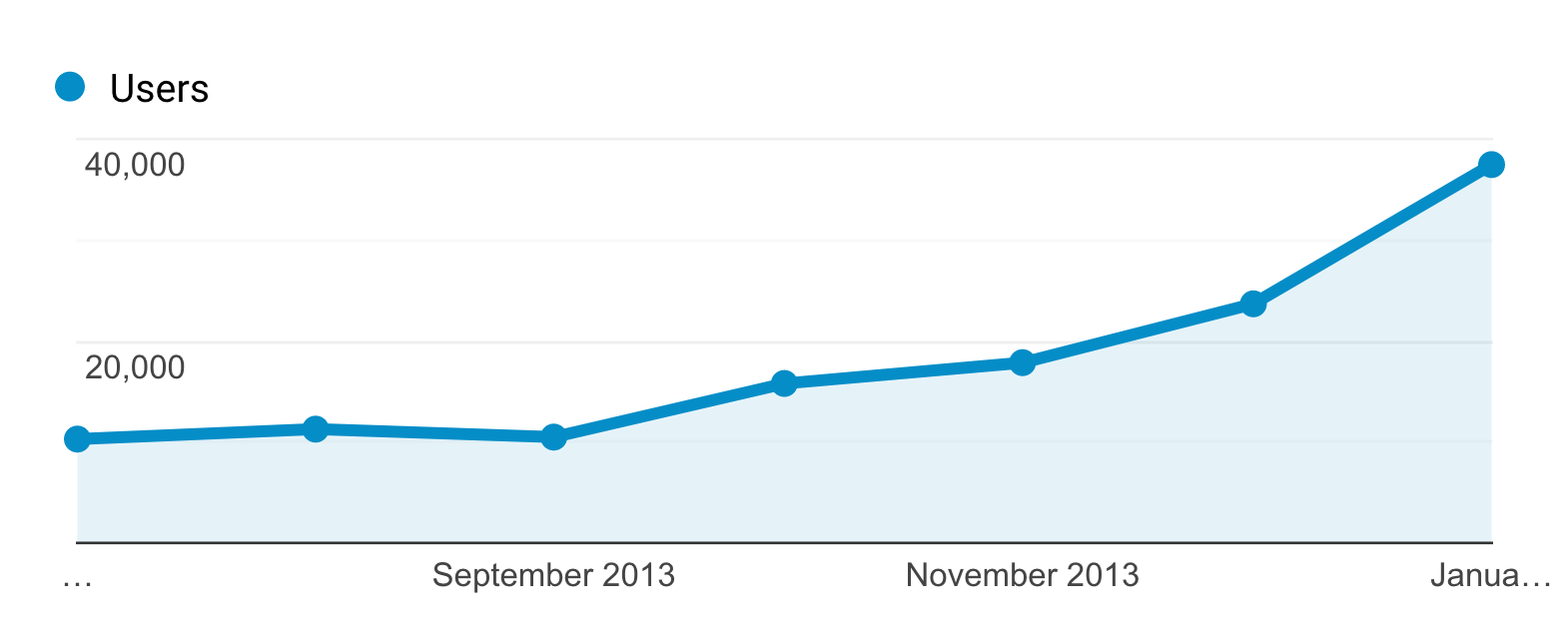
But at a certain point, traffic to the blog started to stall.
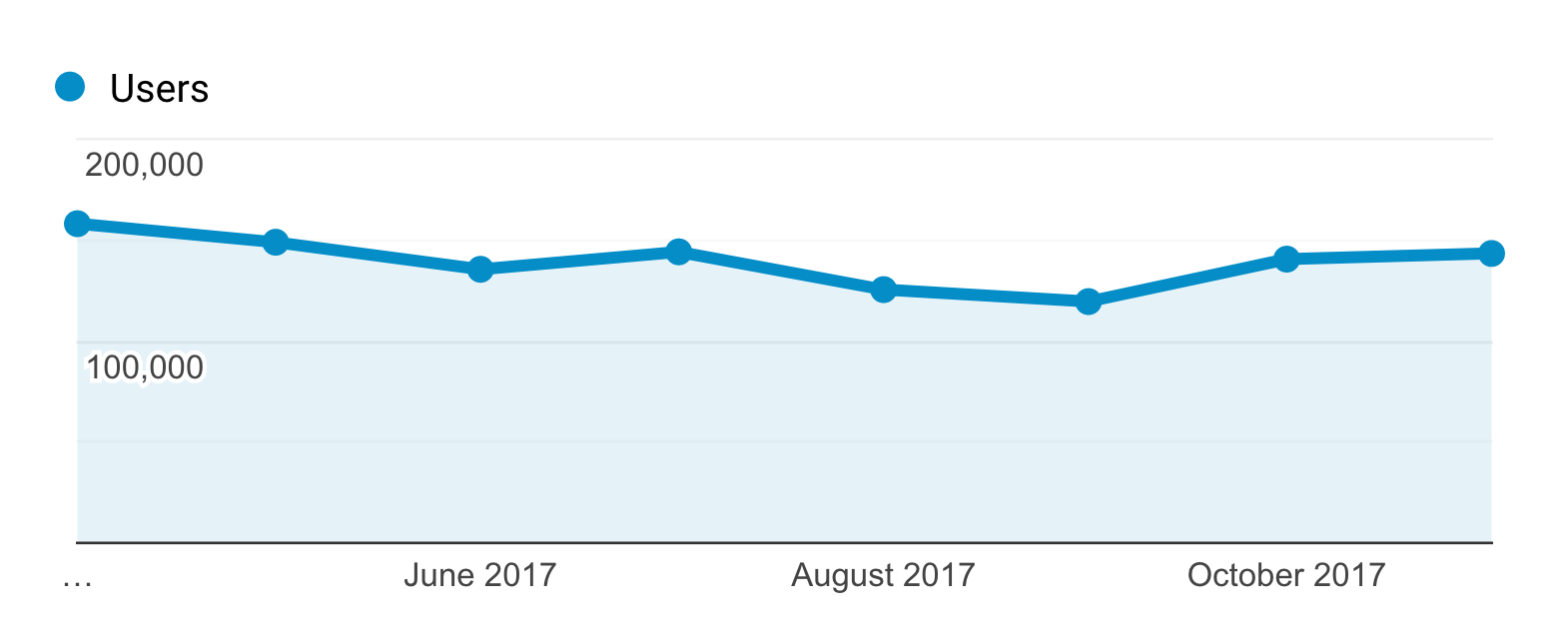
He realized that growing a blog past a certain point with only 10-12 posts per year was pretty much impossible.
And also that you don’t need to execute every single step yourself.
In other words:
You can focus on the stuff you’re good at (In Brian’s case, keyword research and writing). And get help with the things you’re not good at (editing, design, visuals).
This helped our content creation process go from this:
To what it is today:

We now publish 50 articles a month across Backlinko and TrafficThinkTank.com.
Without sacrificing quality.
That said:
Your content creation process will probably look different than ours.
There may be more steps. Or fewer steps.
The idea here isn’t to follow the same process that we use.
Instead, your goal should be to document all the steps you follow for creating content.
Then, get experts to help with some of those steps.
Step #2: Create an Organized Content Calendar
For your content calendar to do its job, it needs to be super organized.
(This is especially true if you’re putting out lots of 10x content, like ultimate guides, industry studies, or content hubs.)
As mentioned in step #1, “creating content” is a process with dozens of smaller steps.
And if you want to scale up, you need a way to list each step that needs to be done. And the current status of those steps.
Otherwise, and trust us on this one, something WILL fall through the cracks.
Today, our content schedule acts more like a project management system than an actual calendar. We use a combination of Google Sheets, Notion, and Monday.com.

So, if you already have a content calendar, great.
If not, make it a top priority.
And even if you have a calendar, take a second look at it to see if there’s any way that you can improve it.
Specifically, try to have every single tiny step laid out as a checklist. That way, nothing falls through the cracks.
For example, in 2024, we migrated our content calendar from Notion to Monday.com so we could get even more granular about each step.

For one article, we have 12 stages, including substages, for three revision rounds.
Each stage is grouped into one of five queues, including:
- Writer’s queue
- Editors queue
- Designers queue
- Developers queue
- Distribution queue
This gives us end-to-end visibility on our production so we can improve efficiencies.
Step #3: Plan Out Your Content Schedule for the Next 6-9 Months
Planning out Backlinko’s blog content has been a game-changer for us.
Previously, Brian’s team and would have maybe 2-3 posts planned out in advance.
(In fact, sometimes he’d only start writing a post after the last one came out.)
This led to rushed projects, stressed-out staff, and posts that weren’t as good as they could have been.
Today, we have the next 6-9 months of content planned out.

Which is a HUGE stress reducer.
Everyone on the team knows exactly what’s coming up. So there’s zero stress wondering what the future looks like. And you can account for seasonality.
The other great thing about having a 6-9 month plan is that you can batch things.
Especially keyword research.
So, instead of logging into a keyword research tool every single time you want to write something, you can spend a day 100% focused on finding topics and keywords.
Then, map those topics in your content calendar for the next few months.
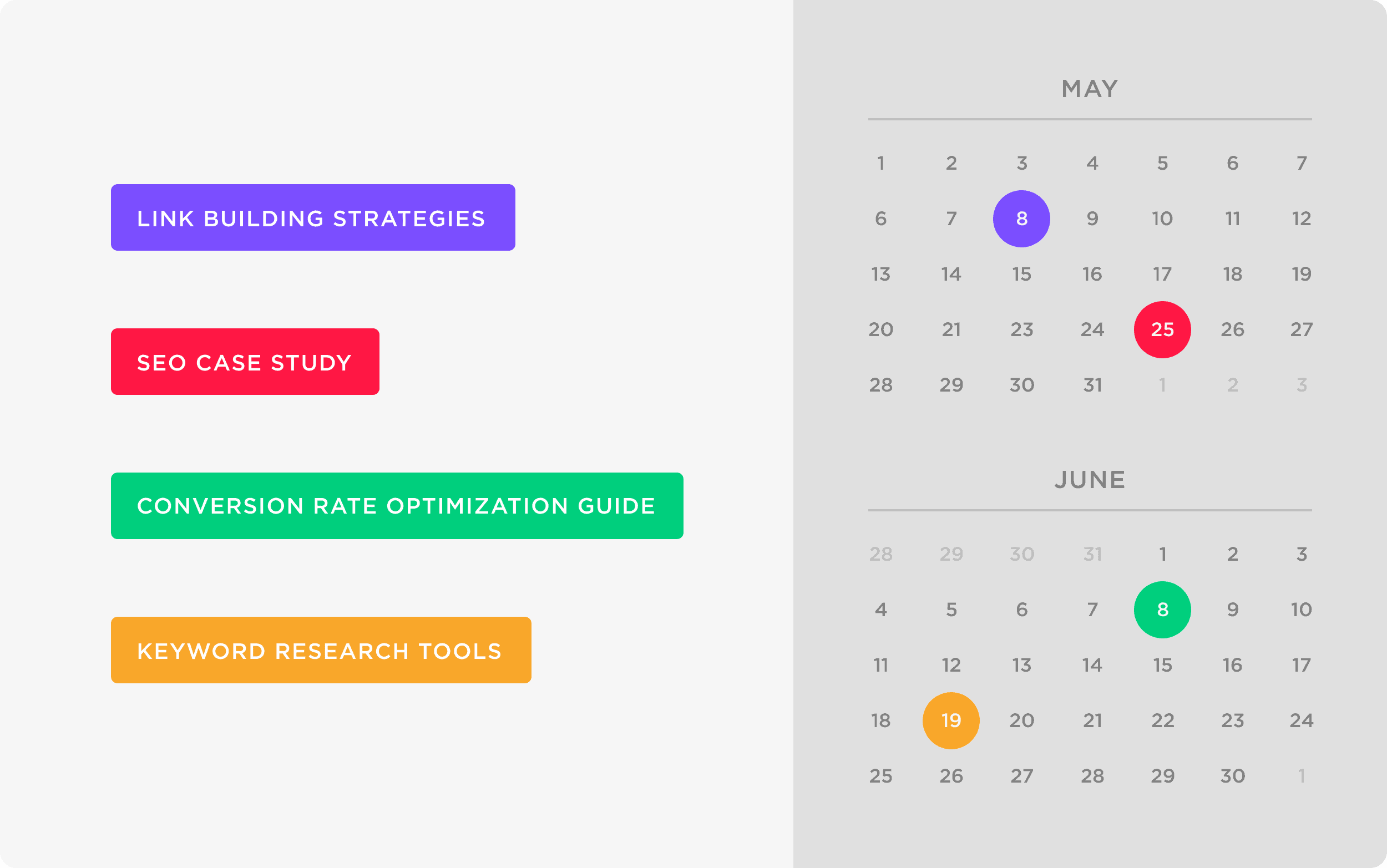
We use Semrush’s Topic Research tool to generate dozens of content ideas in seconds.
Say we want more topics to complement this article on scaling content. Type “scale content” into the search box, and hit “Get content ideas.”

Clearly, there’s a lot of interest in using AI to scale content production.

You can also view content ideas in a mind map.

Very handy.
Now, there’s one thing to point out here:
This plan isn’t set in stone. You can always change, add, remove, or shuffle things around.
Start your keyword research
Explore the largest keyword database.
Step #4: Create Detailed Briefs for Each Post
A good content brief sets your writers and editors up for success. It provides a clear direction and objective for every article.
SEOs and Content Strategists create our briefs. The document includes:
- The primary and secondary keywords
- The post type (e.g., listicle, how-to, hub page, etc.)
- The search intent and target audience.
- Notes for the writer (content angles, differentiation, featured snippet opportunities)

During the briefing stage, you can include a detailed outline (more on that in the next step) or leave it to the writer.
We sometimes use AI tools like ChatGPT and Frase to understand what’s currently ranking and find a unique perspective that aligns with Backlinko’s brand tone of voice.
Step #5: Outline Your Articles
Create detailed outlines before you write.
Many of us like to approach writing blog posts like Ernest Hemingway: grab a cup of strong coffee, whip open WordPress, and start banging on your keyboard.
That may work for a genius like Ernest Hemingway.
But for us regular folks, writing freestyle like that is slow. And, more often than not, the final product doesn’t turn out that great.
Today, we write everything (including this post you’re reading) from a detailed outline.

Not only is this way faster than writing on a blank page, but it makes your content more organized and structured.
An outline gives you a high-level overview of what you want to cover.
That way, you can see if you’re missing any important steps or strategies. Before you write a single word.
And it also allows your editors to provide early feedback so writers and editors are on the same page.
For example, here’s the outline for: What Are Canonical URLs: An In-Depth Guide for SEOs.

This outline made it easy to see whether or not the writer covered the key points that needed to be covered. And the editor made suggestions on the structure.
Once you start writing, all you need to do is fill in the blanks with details.
That’s the power of outlining.
Step #6: Set Your Team Up for Success With Helpful Resources
Style guides, checklists, and evaluation tools are essential. They help your team produce exceptional content consistently.
Brian Dean’s writing style is direct, punchy, and highly actionable. He openly shares his successes and failures to establish trust and engagement.

And he’d often have 60-70% of the pixels on a blog post dedicated to visuals.
Needless to say, we’ve struggled to replicate his style at scale.
But we’ve found a balance between Brian’s unique style and featuring the voices of a larger team.
Developing writer resources has been crucial for producing high-performing content.
Here are our go-to resources:
Content Guidelines
This is like our internal content bible, where we document how we approach search intent, post titles, visuals, formatting, and more.

Article Checklist
We picked a dozen items from our guidelines to serve as quick references for writers before they submit their drafts.

Writer Evaluation Tools
Consider developing a scoring system for every draft based on your content guidelines.
For example, Airtable’s content team uses a detailed scoring system for writers. It includes tone, structure, hook, accuracy, and other criteria.
This is brilliant, as it makes your feedback more constructive and consistent. Even better if you can make your content evaluation based on your guidelines.
We do something similar. It’s been invaluable to see trends, make improvements, and give feedback.
Step #7: Hire Great Editors
Work with editors knowledgeable in your industry and intimately understand your brand style.
They’ll ensure your content remains top-notch and consistent, no matter how much you increase your output.
We’ve learned even the best writers at the highest rates need editing. And they appreciate the extra support and development.

If you don’t hire an editor, guess what? You’re the editor. Which isn’t scalable.
We’ve found editors through referrals, job boards, and LinkedIn. Asking our freelance writers for the names of editors they’ve enjoyed working with has helped find leads.
We test editors’ SEO knowledge and ability to follow our guidelines.
And provide a bunch of resources for them when they start working with us.

Step #8: Hire Domain Experts or Great Writers and Connect Them with SMEs
Brian Dean wrote every word on Backlinko until 2023, a truly impressive (and tiring) feat.
But if you’re like most businesses that want to scale content marketing, you’ll eventually need to hire writers.
At a high level, hiring a freelance writer is easy:
Post a job to Upwork.
Hire someone who can string a few words together.
Unfortunately, that’s how most people outsource writing. This is why 99.9% of all content online is hot garbage.
Instead of hiring randos off of Upwork, you have two options:
- Work with domain experts
- Connect talented writers with SMEs
Option #1: Work With Domain Experts
Ideally, hire people with first-hand knowledge of what they’re writing about.
For example, NerdFitness came out of nowhere in a competitive space. And a big reason for its success was the fact that the founder, Steve Kamb only wrote about stuff he knew about.
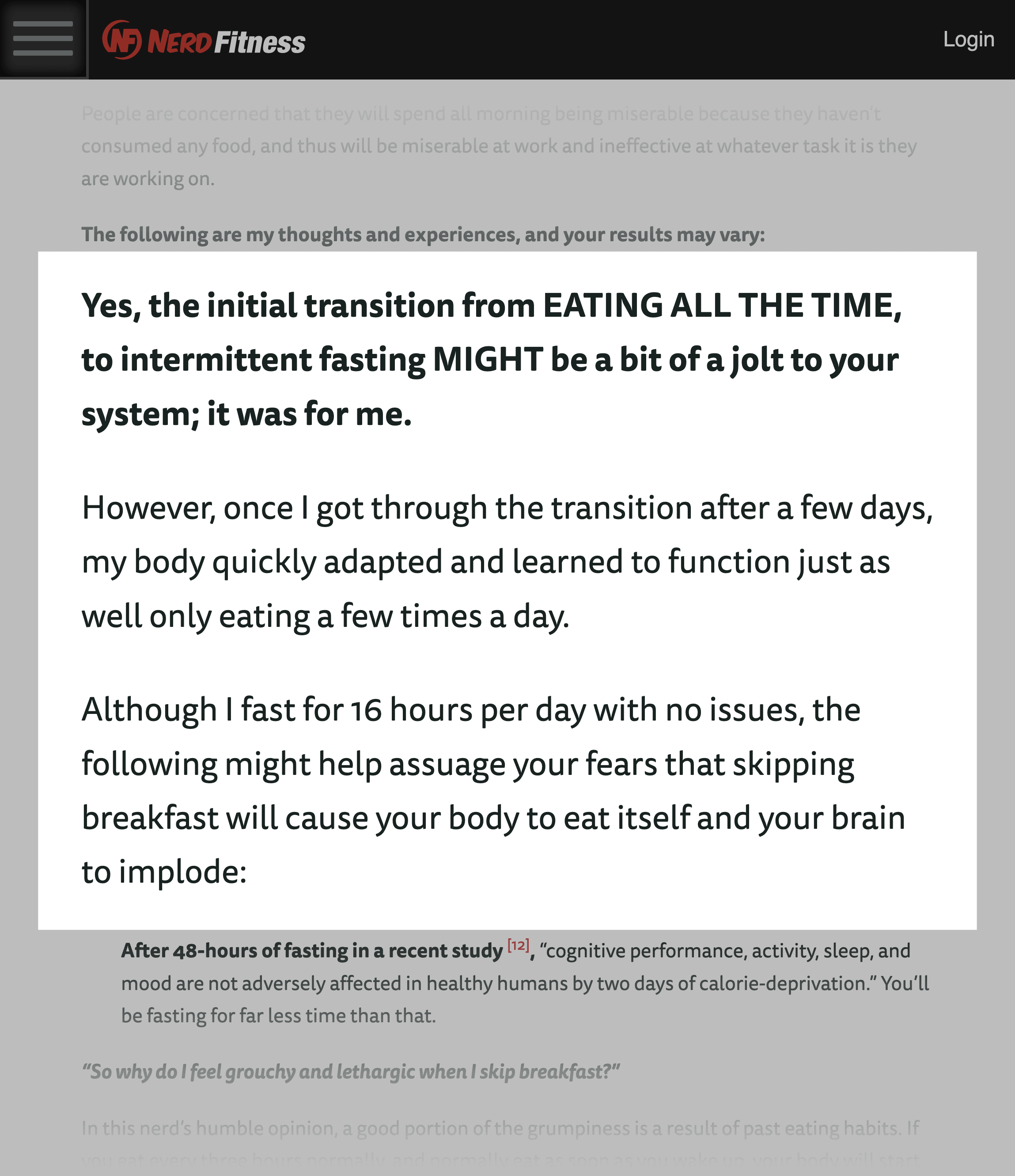
Question is:
How do you find domain experts?
First, find people who run blogs in your industry. And offer to hire them.
For example, let’s say that you run a blog about personal finance. Well, if you Google “best personal finance blogs,” you’ll find curated lists of awesome blogs in that niche:

Then, ask the people who run those blogs if they’re available to write content for your site.
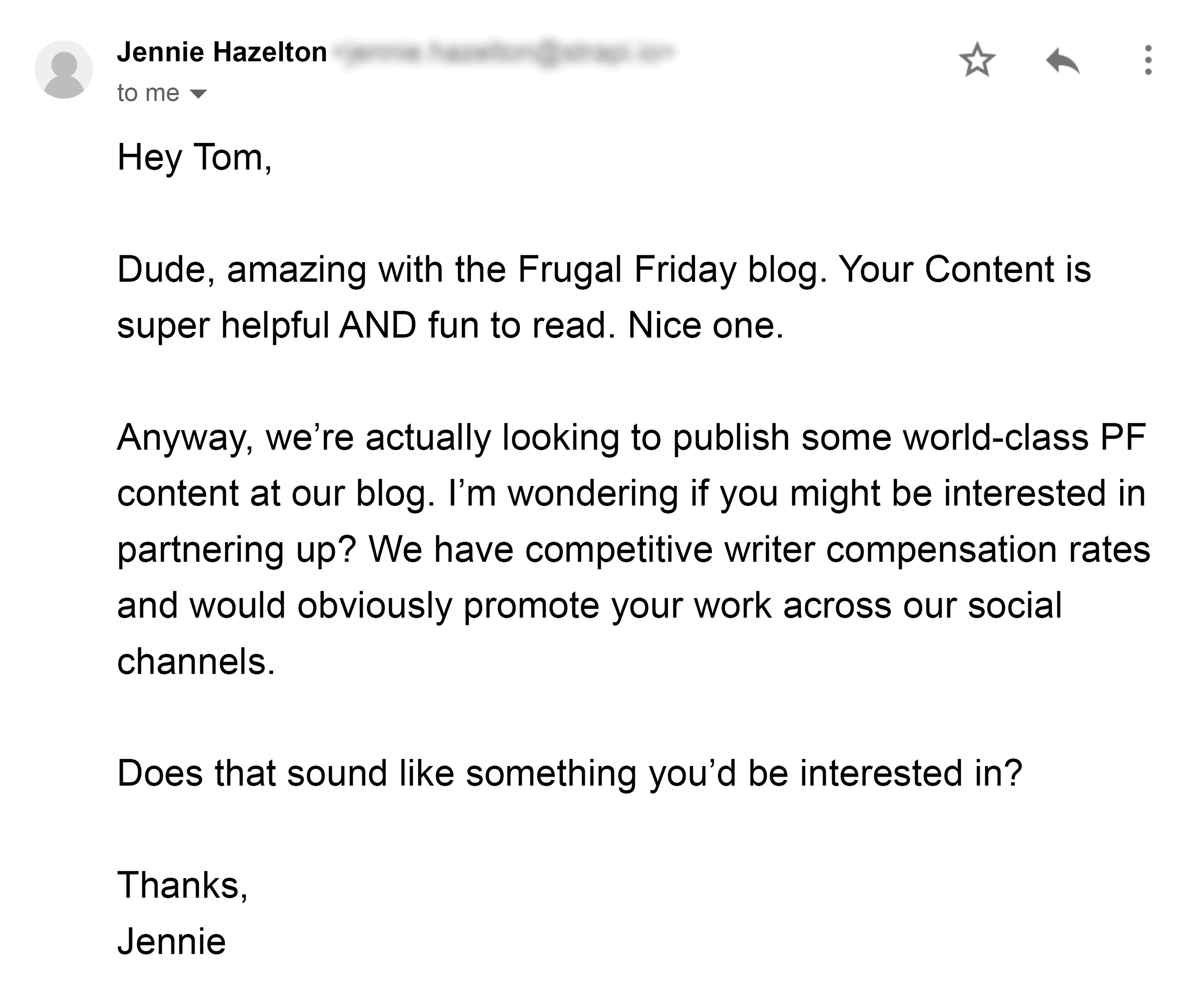
Second, look for people who contribute to other sites in your niche.
“If you want an article about unclogging a toilet, don’t hire a freelance writer. Hire a plumber.”
Unless.
You connect your writer with a plumber. Which brings us to the next point.
Option #2: Connect talented writers with SMEs
Finding a great writer who’s also a practitioner in your industry is possible but challenging.
A more scalable approach may be to hire solid writers and then have them interview Subject Matter Experts (SMEs) for your articles. Your SMEs can be internal or external experts on your team.

SMEs bring first-hand experience and authority to your content, a critical E-E-A-T signal. SEO aside, SME input makes your content more helpful.
For instance, this Programmatic SEO guide showcases this approach brilliantly. They interviewed several well-known SMEs and used their first-hand insights as the foundation for much of the guide’s content.
If you choose this path, you’ll still want to find high-quality writers. Choose them based on their experience and samples. Also, on their industry knowledge and ability to adapt to your guidelines.
Use recruitment channels like industry job boards, referrals, and LinkedIn. And you can still find excellent writers on marketplaces like Fiverr and Upwork.
The added kink here is creating a list of SMEs you can connect with your writers.
For example, in our International SEO guide, we partnered with two external SMEs and one internal SME.

They added first-hand perspectives to a technical topic.
Step #9: Start With a Limited Paid Trial
Start by inviting new writers to join a paid trial to showcase their skills. This allows you and the writer to determine whether it’s a good match.
Moreover, you gain valuable insights into their level of professionalism and how they incorporate feedback.
After we confirm the rate and availability, writers must pass a short test. Once they’ve passed the test, we hire them for two paid trial articles.
We’re looking for improvements between the first and second revisions. The writer is becoming familiar with our guidelines. Then we expect a big improvement between the first and second articles.
We provide feedback after each assignment and assess whether the writer meets expectations. If not, we move on to other candidates. But usually, our tests increase the chances of the writer being a good fit.
Step #10: Repurpose Content into New Formats
Content repurposing involves taking a single piece of content and repurposing it in several formats.
Like taking a blog post and turning it into a newsletter, a video, a podcast, or a social media post.
And when done right, repurposing is a fantastic way to scale content creation.
For example, one of our most popular posts is: The Complete SEO Checklist.

But this same content had lots of potential as a video.
That said:
You can’t just read a blog post in front of a camera. That wouldn’t work.
For content repurposing to work, you need to tweak the original content so it 100% fits the new format.
So, with Backlinko’s SEO checklist video, Brian ended up cutting out 60% of the content from the post (otherwise, the video would have been 45 minutes long).
Instead, he only covered the key steps from that post.
He also added a handful of new tips and examples to make the video more engaging.
The final product was this video:
And because extra time was taken to make original content work as a video, people really liked it.
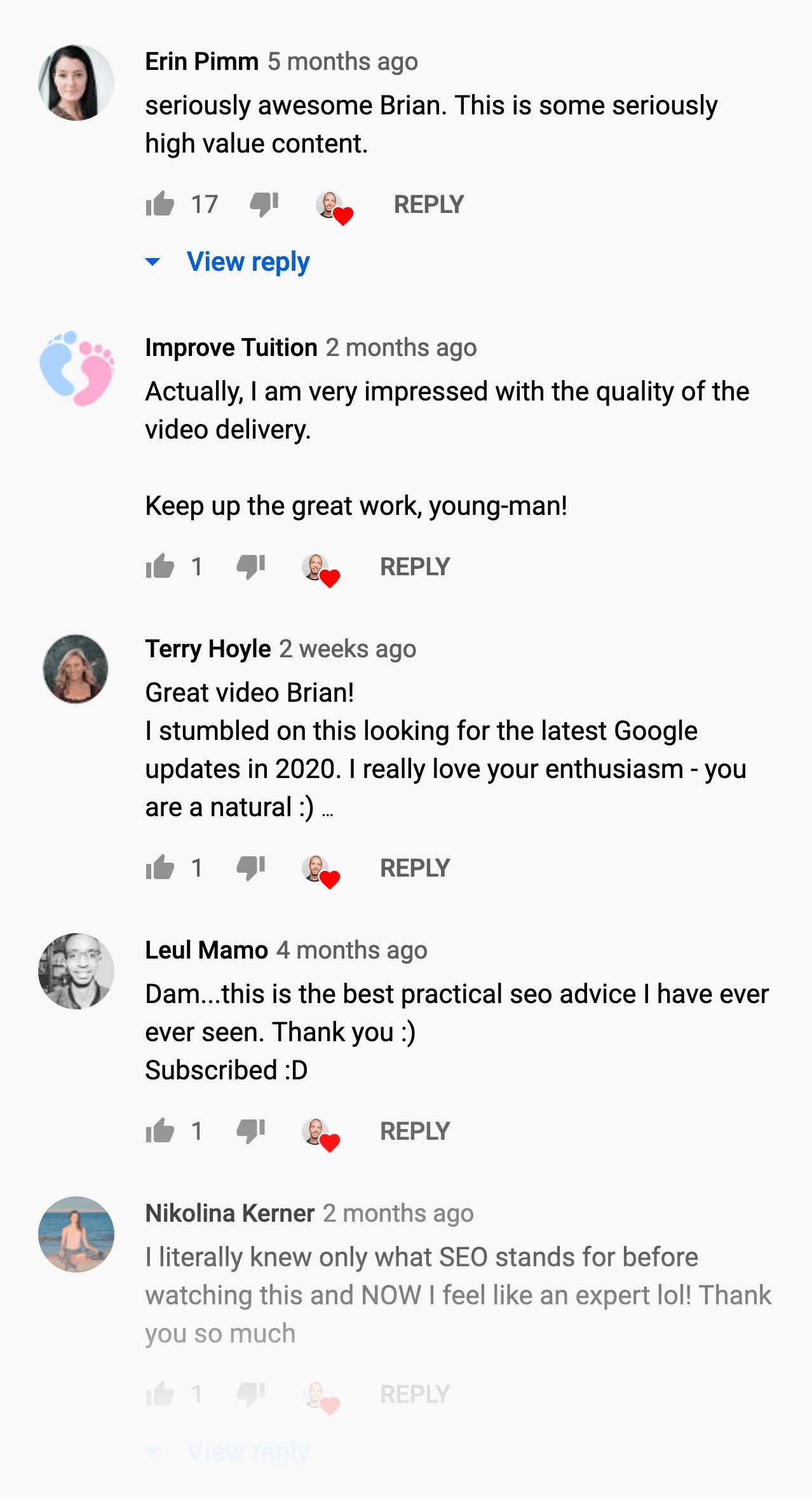
Which has led to that video accumulating 556,000 total views so far.

Not bad.
Step #11: Continuously Iterate and Improve
Treat your content production cycle like an evolving product.
Review performance metrics. Look at engagement, traffic, and SEO rankings, and use them to find areas to improve.
Source feedback from writers, editors, designers, and, of course, readers. For example, in Slack, one of our writers shared how she was creating a checklist for each article.
“I think making a list of all the things I struggle with and checking against them as I write is my biggest tip.”
So, we created an article checklist as a resource for writers.
We do the same for our content guidelines. Our Lead Editor updates the content guidelines at least once a quarter based on areas for improvement and team feedback.
“Our style guide isn’t a static document. I review every new article we publish, which helps me see trends that need addressing. I also rely on feedback from editors, writers, SEOs, and designers.
Articles requiring extra revisions or taking longer than expected usually have a root cause. It’s something we can improve in our resources or an opportunity to coach team members.”
When you update your guidelines, summarize what’s changed with the team. That way, your team can skip to the sections with new information. Much like adding features to a software product.

The same approach applies to processes. Start tracking how long it takes to publish content from ideation to going live on your website. Is it two weeks or six weeks?
This data is invaluable for forecasting how much content you can create. And what you can improve to make your publishing cycle more efficient.
Next Steps for Scaling Your Content Production
Going from a handful of articles to 10, 20, or 50+ posts per month (without compromising quality) requires thinking differently.
You go from viewing your content as a product to seeing your entire production cycle as a product.
To get started, go back to step #1. You’ll struggle to scale without understanding each step in your publishing process.
To help, read our guide on writing a blog post. This will help you list each production step and create a baseline for your content guidelines.
Reveal any company’s website traffic
Spy on your competitors’, prospects’, and potential partners’ website traffic.
Backlinko is owned by Semrush. We’re still obsessed with bringing you world-class SEO insights, backed by hands-on experience. Unless otherwise noted, this content was written by either an employee or paid contractor of Semrush Inc.

